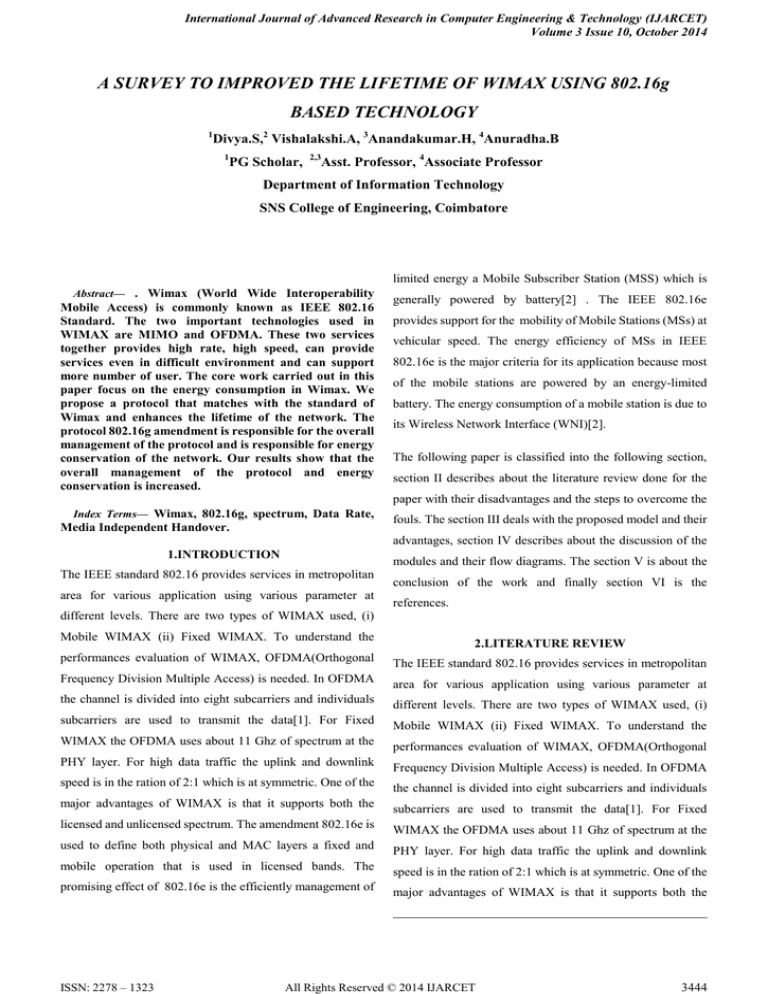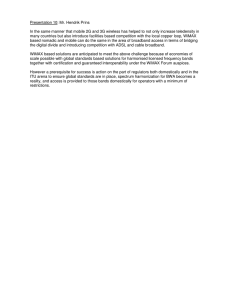
International Journal of Advanced Research in Computer Engineering & Technology (IJARCET)
Volume 3 Issue 10, October 2014
A SURVEY TO IMPROVED THE LIFETIME OF WIMAX USING 802.16g
BASED TECHNOLOGY
1
Divya.S,2 Vishalakshi.A, 3Anandakumar.H, 4Anuradha.B
1
PG Scholar,
2,3
Asst. Professor, 4Associate Professor
Department of Information Technology
SNS College of Engineering, Coimbatore
limited energy a Mobile Subscriber Station (MSS) which is
Abstract— . Wimax (World Wide Interoperability
Mobile Access) is commonly known as IEEE 802.16
Standard. The two important technologies used in
WIMAX are MIMO and OFDMA. These two services
together provides high rate, high speed, can provide
services even in difficult environment and can support
more number of user. The core work carried out in this
paper focus on the energy consumption in Wimax. We
propose a protocol that matches with the standard of
Wimax and enhances the lifetime of the network. The
protocol 802.16g amendment is responsible for the overall
management of the protocol and is responsible for energy
conservation of the network. Our results show that the
overall management of the protocol and energy
conservation is increased.
Index Terms— Wimax, 802.16g, spectrum, Data Rate,
Media Independent Handover.
generally powered by battery[2] . The IEEE 802.16e
provides support for the mobility of Mobile Stations (MSs) at
vehicular speed. The energy efficiency of MSs in IEEE
802.16e is the major criteria for its application because most
of the mobile stations are powered by an energy-limited
battery. The energy consumption of a mobile station is due to
its Wireless Network Interface (WNI)[2].
The following paper is classified into the following section,
section II describes about the literature review done for the
paper with their disadvantages and the steps to overcome the
fouls. The section III deals with the proposed model and their
advantages, section IV describes about the discussion of the
1.INTRODUCTION
modules and their flow diagrams. The section V is about the
The IEEE standard 802.16 provides services in metropolitan
area for various application using various parameter at
conclusion of the work and finally section VI is the
references.
different levels. There are two types of WIMAX used, (i)
Mobile WIMAX (ii) Fixed WIMAX. To understand the
2.LITERATURE REVIEW
performances evaluation of WIMAX, OFDMA(Orthogonal
The IEEE standard 802.16 provides services in metropolitan
Frequency Division Multiple Access) is needed. In OFDMA
area for various application using various parameter at
the channel is divided into eight subcarriers and individuals
different levels. There are two types of WIMAX used, (i)
subcarriers are used to transmit the data[1]. For Fixed
Mobile WIMAX (ii) Fixed WIMAX. To understand the
WIMAX the OFDMA uses about 11 Ghz of spectrum at the
performances evaluation of WIMAX, OFDMA(Orthogonal
PHY layer. For high data traffic the uplink and downlink
Frequency Division Multiple Access) is needed. In OFDMA
speed is in the ration of 2:1 which is at symmetric. One of the
the channel is divided into eight subcarriers and individuals
major advantages of WIMAX is that it supports both the
subcarriers are used to transmit the data[1]. For Fixed
licensed and unlicensed spectrum. The amendment 802.16e is
WIMAX the OFDMA uses about 11 Ghz of spectrum at the
used to define both physical and MAC layers a fixed and
PHY layer. For high data traffic the uplink and downlink
mobile operation that is used in licensed bands. The
speed is in the ration of 2:1 which is at symmetric. One of the
promising effect of 802.16e is the efficiently management of
major advantages of WIMAX is that it supports both the
ISSN: 2278 – 1323
All Rights Reserved © 2014 IJARCET
3444
International Journal of Advanced Research in Computer Engineering & Technology (IJARCET)
Volume 3 Issue 10, October 2014
licensed and unlicensed spectrum. The amendment 802.16e is
used to define both physical and MAC layers a fixed and
mobile operation that is used in licensed bands. The
promising effect of 802.16e is the efficiently management of
limited energy a Mobile Subscriber Station (MSS) which is
generally powered by battery[2] . The IEEE 802.16e
provides support for the mobility of Mobile Stations (MSs) at
vehicular speed. The energy efficiency of MSs in IEEE
802.16e is the major criteria for its application because most
of the mobile stations are powered by an energy-limited
battery. The energy consumption of a mobile station is due to
its Wireless Network Interface (WNI)[2].
The following paper is classified into the following section,
section II describes about the literature review done for the
paper with their disadvantages and the steps to overcome the
Fig 1 Architecture of 802.16g protocol.
fouls. The section III deals with the proposed model and their
advantages, section IV describes about the discussion of the
modules and their flow diagrams. The section V is about the
4 Discussion
conclusion of the work and finally section VI is the
As upto our knowledge 802.16g has high spectrum
references.
management the spectral efficiency also paves way for the
increase in energy level.. To improve the spectral efficiency
3.PROPOSED MODEL
we use SC-OFDM which more advanced than the OFDM.
The SC-OFDM has more subcarriers to transmit the data and
to improve the efficiency at the other end the interferences is
3.1 802.16g ENERGY EFFICIENCY
reduced
As mentioned above the network lifetime depends upon the
Energy consumed or utilized by mobile station to forward the
data from one point to another point. Our proposed model
802.16g is equipment with procedures and services to enable
interoperable and efficient management of network resources,
mobility, and spectrum. In 802.16g, the management plane
behavior in 802.16 fixed and mobile devices is standardized.
IEEE 802.16g creates standardized procedures and interfaces
for the management of 802.16 devices [IEEE, 2007b] [8].
Fig 2 Spectral Efficiency in 802.16g
Table 1. Spectral efficiency
ISSN: 2278 – 1323
All Rights Reserved © 2014 IJARCET
3445
International Journal of Advanced Research in Computer Engineering & Technology (IJARCET)
Volume 3 Issue 10, October 2014
5 .CONCLUSION
One of the important milestone of 802.16 is that it supports
The Wimax is growing technology but the major drawback
about licensed and unlicensed spectrum. The frequency of an
found in the system was energy level. So we focused our
licensed spectrum is about 5.8, 2.3, 2.5, 3.6Hz and unlicensed
works towards the increase in energy level with The 802.16g
spectrum 2.40, 2.4835, 5.15Hz Onces when the spectral
based technologies. The parameter that was taken into
efficiency is improved the data rate and modulation are the
account for improvising the energy level are spectral
other two important criteria to improvise the energy level.
efficiency, data rate, modulation etc. We conclude our paper
802.16g supports four modulation techniques BPSK, QPSK,
by stating that 802.16g is more efficient than 802.16e in terms
16 QAM and 64 QAM. Maximum data rate can be obtained is
of energy and the overall management.
100 Mhz. The following scenario below explains when the
REFERENCE
user is moving from network to another i.e, from
[1]. Chakchai So-In, , Raj Jain, Abdel-Karim Tamimi,
802.11(WIFI) to 802.16g(WIMAX). If the user is under the
“Capacity Evaluation for IEEE 802.16e Mobile WiMAX”
802.11 standard he will using fixed scheme and in case of
journal of computer systems, networks, and communications,
802.16 it is adaptive scheme. Where user can change
vol. 1, no. 1, april 2010
according to the constraints. The above four techniques are
supported by both the network but the signal strength of
802.16g is higher when compared to the others. The following
table illustrates the modulation techniques with their data rate
[2]. YAN ZHANG AND MASAYUKI FUJISE “ENERGY
MANAGEMENT IN THE IEEE 802.16E MAC” IEEE
COMMUNICATIONS LETTERS, VOL. 10, NO. 4, APRIL 2006
and signal strength.
Table 2. The Modulation frequency of 802.16
[3]. JINGLIN SHI, GENGFA FANG, YI SUN, JIHUA ZHOU,
ZHONGCHENG LI “IMPROVING MOBILE STATION ENERGY
EFFICIENCY
IN
IEEE
802.16E
WMAN
BY
BURST
SCHEDULING” THE IEEE GLOBECOM 2006 PROCEEDINGS.
[4]. LIN TIAN YUBO YANG ; JINGLIN SHI ; DUTKIEWICZ,
E. ; GENGFA
FANG
"ENERGY
EFFICIENT
INTEGRATED
Medium independent is an essential factor for handover
SCHEDULING OF UNICAST AND MULTICAST TRAFFIC IN
management and it even works in Heterogeneous network.
802.16E WMANS" IEEE TRANSACTION 2008
The main of Medium independent handover is to avoid a
restart session after the handover. The power consumption is
minimized once when the user is informed about the network
coverage maps, optimal link parameters, sleep or idle
[5].
JJ
Chen,
JM
efficient sleep scheduling
Liang, YC
Tseng
"An
considering
energy
QoS
diversity for IEEE 802.16 e wireless networks
" IEEE INTERNATIONAL CONFERENCE MAY 2010.
parameter. Since 802.16 is based on the geographical link
once when the particular range is available the connection is
[6]. Yu-Chee Tseng, Jen-Jee Chen, Yen-Chih Yang
made automatically without any interruption
“Managing Power Saving Classes in IEEE 802.16 Wireless
MANs: A Fold-and-Demultiplex Method”
Y.-C. Tseng’s research is co-sponsored by MoE ATU Plan,
by NSC grants
Fig 3 Medium Independent Process.
[7]. Rajinder Kumar, Kaushik Adhikary, Mr.Rohit Vaid
“VERSIONS OF 802.16”
IJCTA OCT 2011
ISSN: 2278 – 1323
All Rights Reserved © 2014 IJARCET
3446

